April is certainly not a foolish time to visit Osaka. Finally, with winter behind us we can start to head outdoors and enjoy more of the regions natural beauty.
You’ll notice connecting with the great outdoors is something of a recurring theme at this time of year.
So join us today, dear readers, as we run through the top 10 things to do in and around Osaka in April.
For off-the-beaten path activities and featured restaurants in April click here.
Table of Contents
Osaka Castle Park Cherry Blossom Viewing, Early to Mid-April
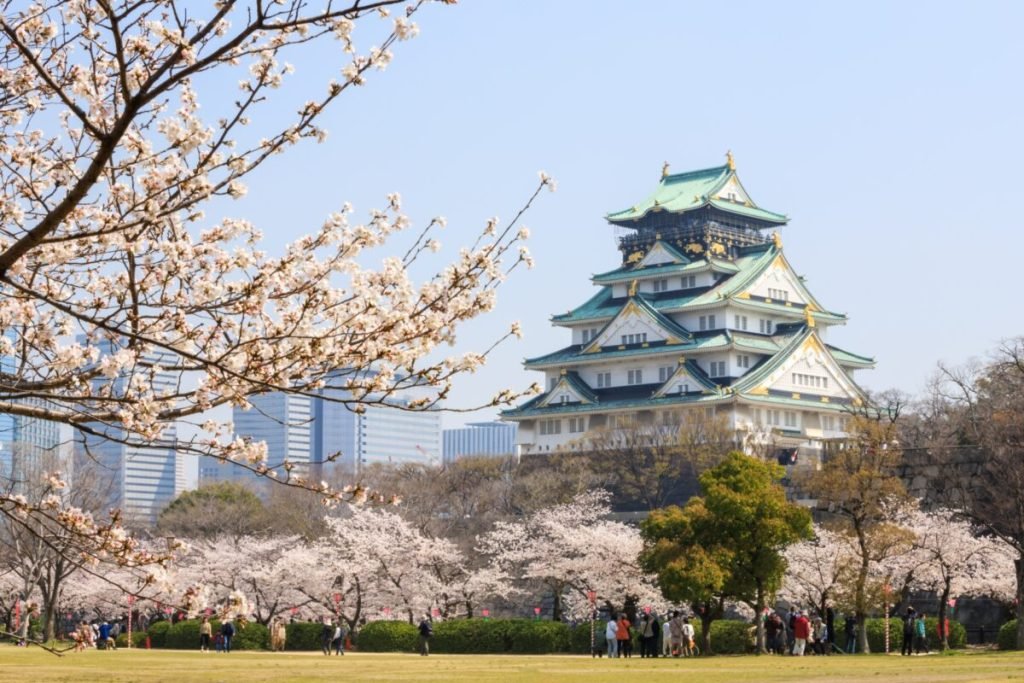
Cherry Blossom trees are something of a natural and cultural institution to the people of Japan. I can honestly say, that throughout all my travels across this wondrous country, there are few better places to survey this botanic beauty than Osaka Castle Park. The castle, originally built by the feudal warlord Hideyoshi Toyotomi, makes for a perfect backdrop as the cherry blossoms take center stage. It is often said that beauty is fleeting. Sadly this is very much the case with the cherry blossoms. Once they reach full bloom, they only stick around for about 2 weeks or so. So, you’ll need to be quick off the mark to enjoy this splendid spectacle.
Typically the trees reach full bloom around the beginning of April. However, climate change, and fluctuating weather patterns mean this isn’t always fixed. Therefore, if seeing the cherry blossoms is a top priority for you, make sure you monitor the cherry blossom forecasts, which usually come out a month or two before full bloom.
The traditional way to enjoy cherry blossom viewing is through a “hanami” event. This is basically a picnic with friends under the trees. Those inclined to do so sometimes like to have a few beers alongside the good food and conversation too. Thankfully, unlike the UK, and some US States, drinking in public parks is perfectly legal in Japan. In fact, come April, some would say it’s even encouraged!
Osaka Nemophila Festival, Throughout April and Early May
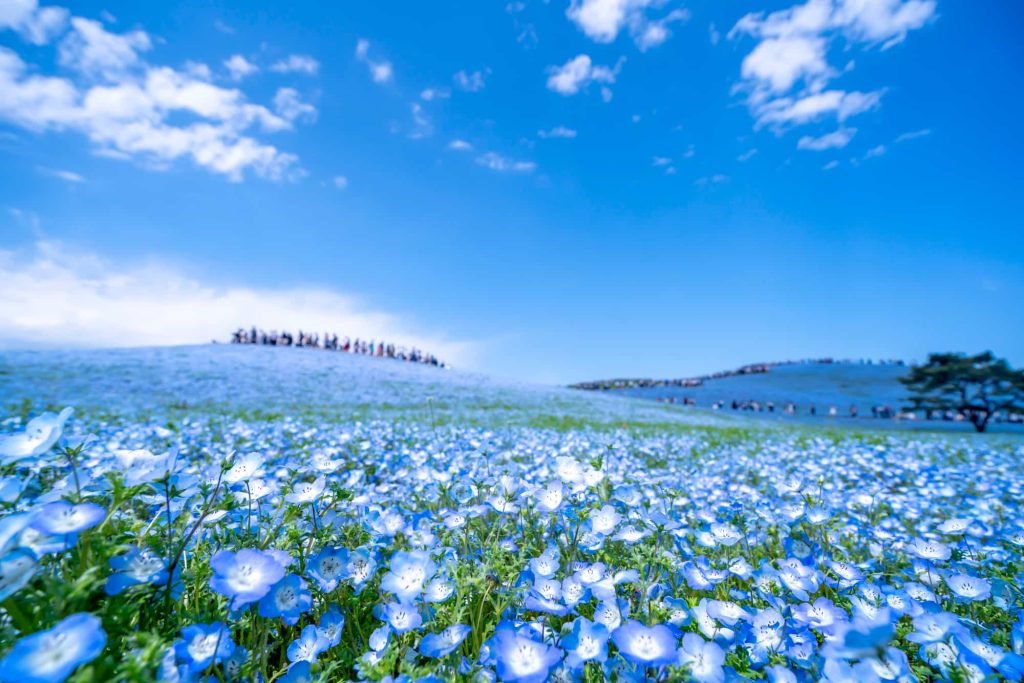
The name may sound like some kind of rare blood disorder, but nemophila are actually one of spring’s most beautiful flowers. April is the time when these flowers reach their full bloom. Osaka Maishima Seaside Park has one million of these delicate blue flowers for you to enjoy. Visitors often describe the festival as “When blue meets blue”. The distinctive hue of the nemophila blends wonderfully with the similarly blue waters of Osaka Bay. On a good day, a clear blue sky rounds off this perfect picture postcard scene.
Also, there’s much more to this festival than just flowers. Local vendors offer a range of traditional produce and crafts for you to enjoy. Of particular note is the nemophila honey, and the scented ice cream. These delicious treats, much like the festival itself, offer a beautiful blend of the traditional and the exotic.
Tickets to enter the festival cost 1,300 yen per person. Children under the age of 12 can enter for 600 yen. Osaka Maishima Seaside Park is a short bus ride from Cosmosquare Station on the Osaka Metro Chuo Line.
Maruyama Weeping Cherry Tree Illumination, First Week of April
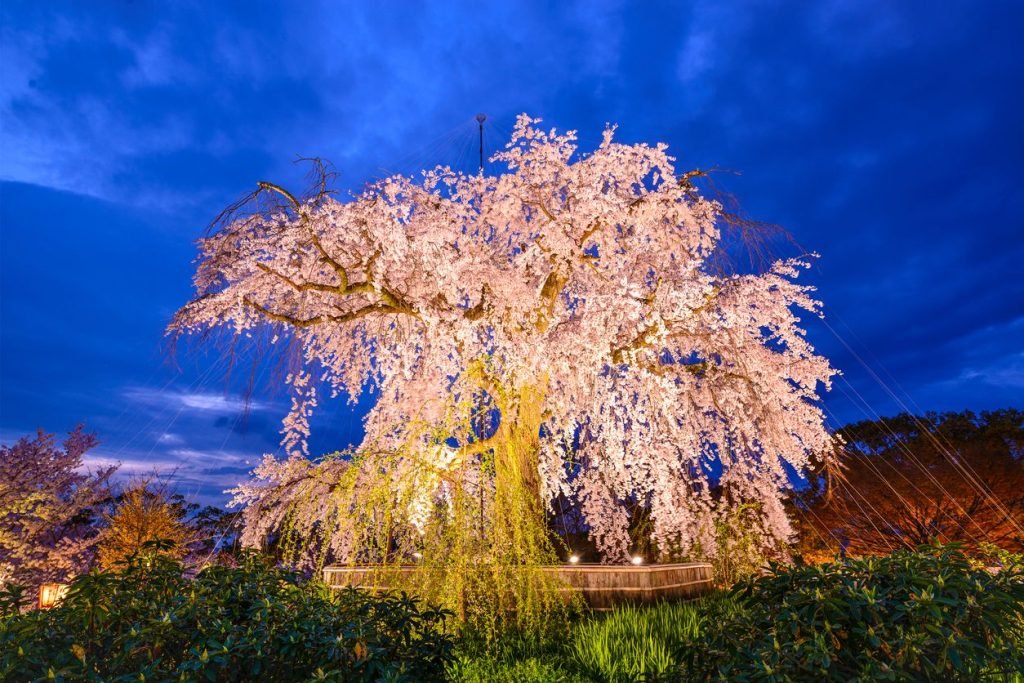
We jump over to Kyoto now for another cherry blossom-inspired festival. This time, we’re going to visit a very special tree, whose history plays an integral part in local folklore.
From the end of March until April 7th, the large weeping cherry tree (so-called because of its drooping, purple/blue blossoms) in Maruyama Park, is illuminated. The lights go on at 6pm and the illumination lasts until the park closes at 10 pm.
As a sideshow, a small bonfire is also lit near the tree. This ritual goes back more than 200 years, to the time of the current tree’s predecessor. Indeed the lineage of this tree goes back centuries. The current weeping cherry tree comes from the seed of its 200 year old predecessor, as indeed did its ancestor.
Admission is free. However, given the popularity of this event, expect Maruyama Park to be very crowded during that first week of April.
Maruyama Park is about a 15 walk from Kawaramachi Station. You can reach Kawaramachi from Osaka’s Hankyu Umeda Station in about 50 minutes or so.
Niku Fes Osaka, Last Week of April
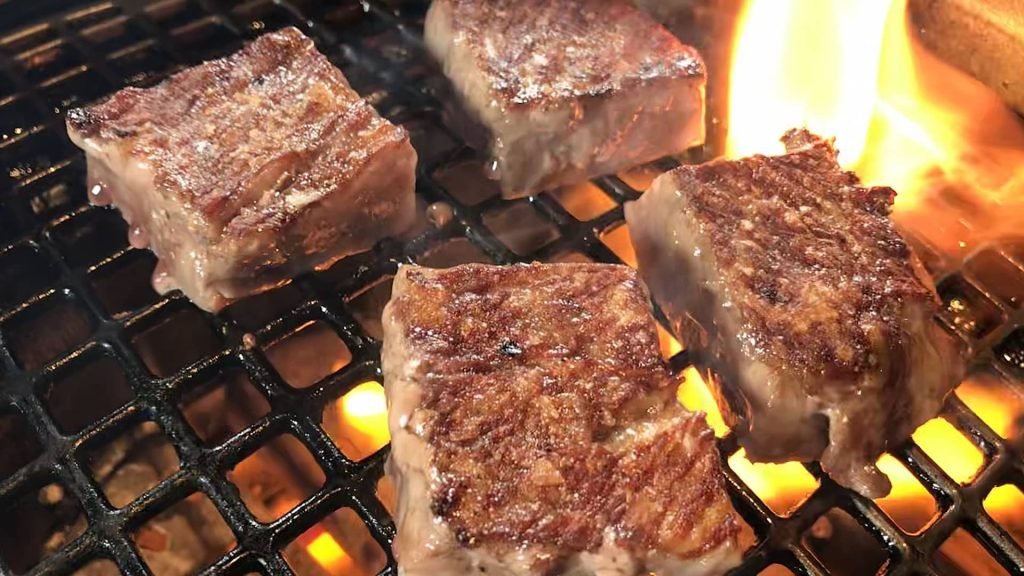
Perhaps all that ambling around parks and looking at cherry blossoms has got you feeling hungry. If so, then Niku Fes Osaka may well be just what you’re looking for.
As the name suggests this is a festival dedicated to meat, in all it’s delicious glory.
Nagai Park plays host to this ten day extravaganza, as butchers and chefs from across Japan, and beyond come to titillate your tastebuds. Basic dishes start from only 700 yen. Of course, if you want to err a bit more on the culinary luxury side of things, then the likes of Kobe beef, and prime rib are also available. Prices rise in accordance with quality though, so remember that sometimes a hamburger is as good as a perfect sirloin!
Thankfully admission is free, so you can set aside a little more for your carnivorous cut of choice.
Niku Fes kicks off on April 27th and runs through to the end of the Golden Week Holidays.
Nagai Park is only a two minute walk from Nagai Station, on the Osaka Metro Subway Midosuji Line. So you won’t have to carry your full belly too far to get home afterwards either!
Tanto Tulip Festival, Mid to Late April

Back onto the flowery business once again. This time, we head over to Hyogo for the Tanto Tulip Festival. However, this is no ordinary flower show. The million or so Tulips that comprise the entire festival are arranged into artistic designs. Often these designs are a homage to memorable characters from Japanese cartoons and popular culture. The likes of Anpanman, Hello Kitty and Crayon Shin-Chan have all featured prominently in previous displays.
Getting to the Tanto Tulip Festival can be a bit of a logistical headache. It’s located around 40 minutes by bus or car from Ebara station, which itself is about 35 minutes from Osaka. However, its well worth the effort to see some of the cutest flower arrangements you’ll find anywhere this spring. Plus. It’s only 800 yen to get full access to the event.
The Tulip Festival has been a stable of Springtime in Kansai ever since its inception, all the way back in 1992. It may not have the bombast of some of the other events we’ll list here today, but it certainly has a devoted following.
Miyako Odori, Throughout all of April

In our March listings, we talked about the beauty, grace and elegance of the Kitano Odori.
Well, if Geisha and their apprentices putting on a spectacular show is your kind of thing, then the Miyako Odori is the main course, to Kitano’s appetizer.
Afterall, Gion is the spiritual home of all Geisha. So, it’s only appropriate that the most popular Geiko and Maiko show of the year should take place there. The Minami-Za Kabuki theater is our venue. A total of 60 performers, all decked out in magnificent, vibrant costumes, take to the stage during the hour long performance. In all, 8 scenes play out over the course of the show, covering the 4 seasons. So, one could say this truly is a show for all seasons!
Tickets are 4,000 yen per person. There are 3 shows per day during Miyako Odori’s theatrical run. You have the options of 12.30, 2.30 or 4.30pm.
The theater is a short walk from Kawaramachi Station, on the Hankyu Line. It takes about 50 minutes to reach Kawaramachi from Umeda.
Unlike Kitano Odori, this event is far more difficult to get tickets for on the day. So, online reservation is highly recommended. Ticket sales usually go live sometime in February. Be sure to regularly check the official Miyako Odori English website regularly for updates about this year’s show.
Hirano Shrine Okasai, 2nd or 3rd week of April
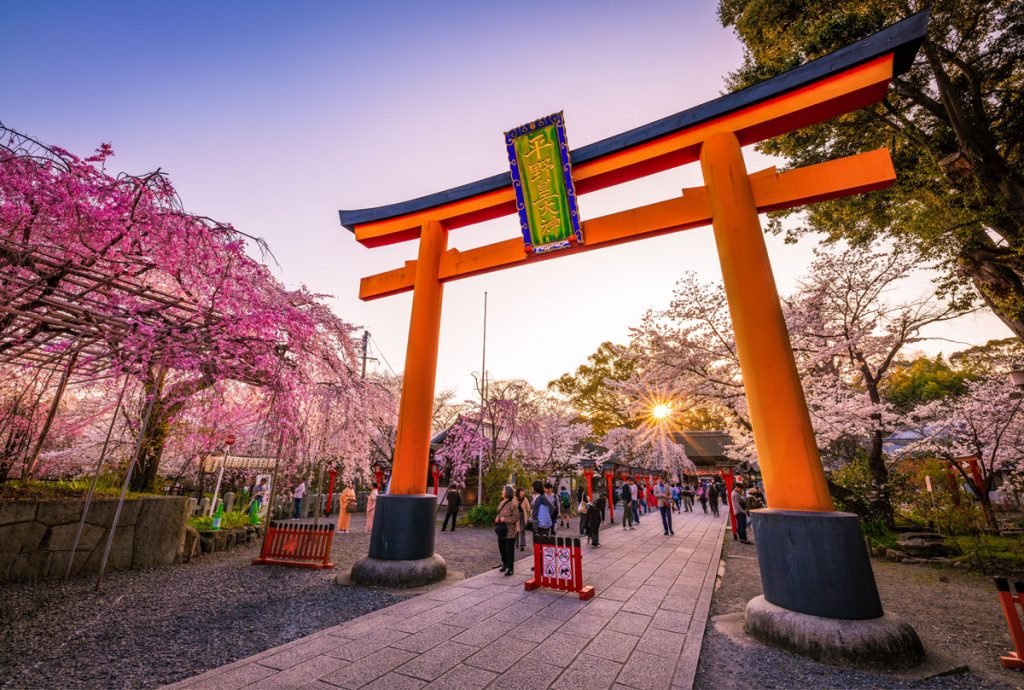
Staying in Kyoto, up next we have the Okasai Matsuri. This cherry blossom procession takes place at Hirano Shine, in the Kitano Tenmangu shrine complex, close to the venue of last month’s aforementioned Kitano Odori.
In April, especially in Kyoto, finding a less touristy, and less crowded place to enjoy the cherry blossom trees can be a very trying time.
However, you’ll notice more local faces than foreign at Hirano Shrine. It’s a bit of a trek from the train stations and the main tourist traps. However, for an event as steeped in history as this, it’s well worth the added effort.
The earliest recorded date for this festival is the year 925 AD, in Japan’s Heian Period. At that time, Kyoto, or Heian-Kyo as it was called back then, was Japan’s imperial capital. Some believe the festival may date back even further, to Hirano Shrine’s foundation in 794 AD.
In either case, we’re talking about over a millennium of cultural significance here.
The procession takes place around April 10th each year, but the exact date varies according to the calendar.
Proceedings open with a religious ritual at 10am. The Shinto Priests then proceed to Emperor Kazan’s mausoleum for prayers from 11am.
The main parade kicks off at 1pm. As well as Shinto priests in their full regalia, you’ll also see participants in Heian period dress carrying mikoshi (portable shrines). You’ll also see men dressed in full, authentic samurai armor, mounted on horseback. All the while, the cherry blossom trees, in full bloom provide the most perfectly picturesque backdrop.
You can reach Kitano Tenmangu by bus from Shijo Omiya Station on the Hankyu Line.
The Kyoto Imperial Palace, Mid April (Subject to weather)
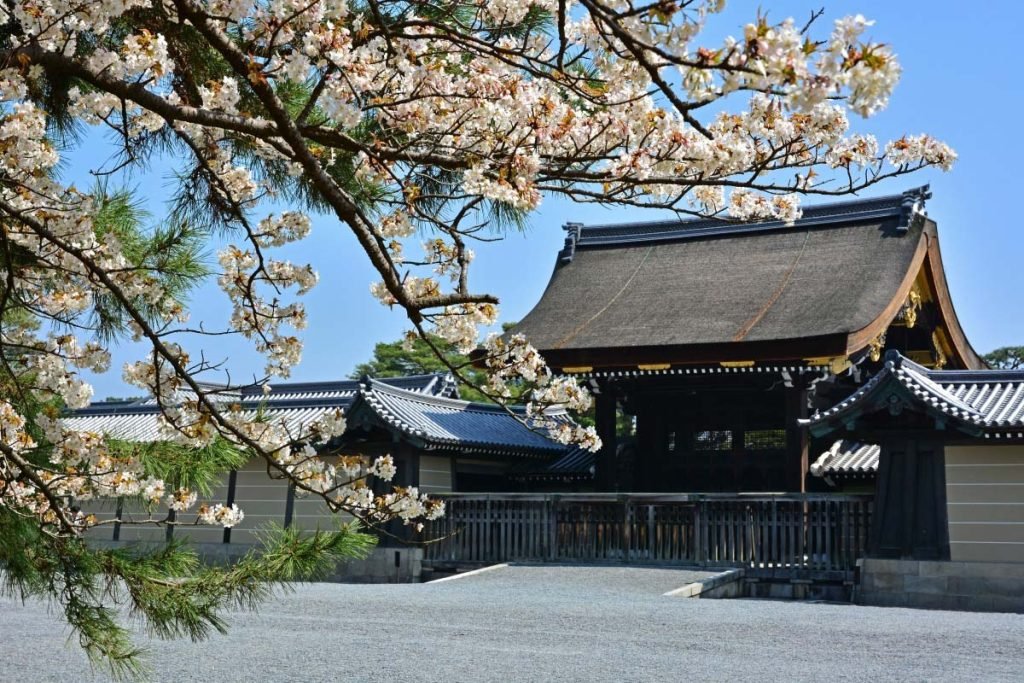
For a brief period, usually about 10 days or so during the peak of the Cherry Blossom season, Kyoto’s Imperial Palace opens to the general public.
Although tourists can visit the palace grounds all year round, it is only during this brief window, and another similar short spell in Autumn, when tourists can access the palace itself. If you’re fortunate enough to be in Osaka when this happens, then you absolutely must take the time to see this place of tremendous historical significance.
For more than 1000 years, Kyoto’s Imperial Palace was the seat of absolute power over Japan. From 794, right up until the Meiji restoration in 1868, Japan’s rulers lived here.
Admission to this rare spectacle is free. To get there, first take the JR Line, or if you’re especially wealthy and impatient, the Shinkansen to Kyoto Station.
From there, take the Karasuma Subway Line to Imadegawa Station. The Imperial Palace is less than a five minute walk from there.
Spring Kemari Matsuri, April 29th
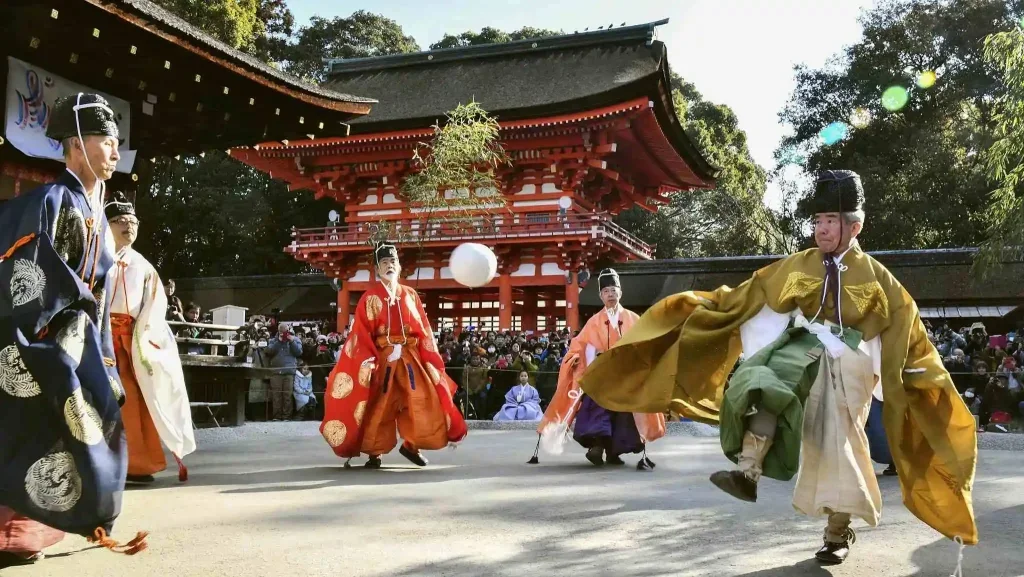
Our penultimate April activity takes us over to Nara. The Kemari Festival is considerably less formal than what you may expect from most Shinto rituals. Once the requisite rites have been performed you can stand back and watch the, at times comedic, spectacle of Shinto Priests dressed in 7th century robes, kicking an oversized ball around. This ball is the “kemari” which gives the festival its name. Imagine your grandad trying to play soccer whilst doing all he can to avoid tripping up on the multi-coloured tent he’s wearing like a jacket. You get the idea.
If you like your authentic Japanese traditions with a sprinkling of physical comedy, then this is the show for you!
The event takes place at Tanzan Jinja Shrine, a 20 minute taxi ride from JR Sakurai Station. Come early, there’s usually quite crowd. The exact kick-off time (pun fully intended) is announced a few weeks ahead of the event. Be sure to check a few days beforehand to find the exact time.
Sei Rei Kai Dance Festival, April 22nd
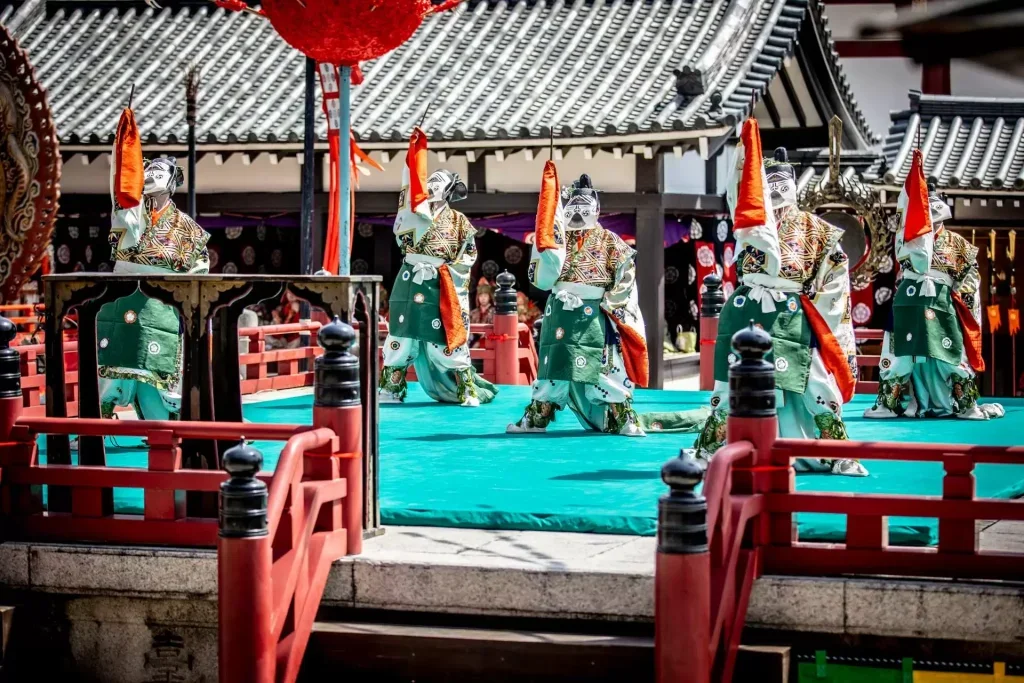
It seems only fitting that we close out today’s listings where we started, and indeed where it all started for Osaka, at Shitennoji Temple. The Sei Rei Kai is a dance ceremony held on the 22nd of April every year. It is held to honor the memory of the founder of Shitennoji Temple, Prince Shotoku. He founded this, Japan’s first Buddhist Temple in 593 AD. As well as the dance ceremony itself, you’ll find various stalls and photo opportunities dotted around the Temple grounds during this, the most celebrated day of the year, at one of Japan’s most celebrated religious landmarks.
Thanks for Reading
And with that, we bring our April activities round up to a close. Hopefully you found at least a couple of interesting things to do here. Of course, if you didn’t then feel free to tell us what we missed in the comments. The beauty and intrigue of Osaka lies in the fact that, no matter how many events we cover here, or how in depth we go, this is a city that never ceases to throw up a surprise or two, whenever you choose to visit.





















